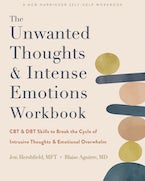By Jon Hershfield, MFT, coauthor of The Unwanted Thoughts and Intense Emotions Workbook
It is well understood that treatment for obsessive-compulsive disorder (OCD) requires two changes to occur. First, one must be able and willing to examine their experiences differently. That is, to think differently about what triggers them. This can be supported by a combination of mindfulness (nonjudgmental awareness of the present experience) and cognitive challenging (questioning the assumptions that led to obsessing). The other is to change the conditioning of one’s responses by changing the behavior. In other words, leaning into exposure to one’s triggers rather than compulsive avoidance or other rituals (exposure and response prevention, or ERP). These two concepts are housed under the umbrella of cognitive behavioral therapy (CBT). Also under this umbrella is a psychotherapeutic modality called dialectical behavioral therapy (DBT). DBT includes a wide variety of tools for letting go of judgment, reducing emotional intensity, tolerating distress, and communicating one’s needs effectively. It’s easy to get confused, and confuse your clients, when one approach emphasizes engagement with distress (ERP) and another approach emphasizes reduction of distress (DBT). But ultimately how one engages with distress effectively is the key to making OCD treatment click. Here are some considerations:
Self-validation vs self-reassurance
Sticking up for oneself when struggling with OCD is no easy feat. If your client is dealing with a pervasive sense of guilt over having what they believe is an immoral intrusive thought, they may be compulsively trying to prove that they’re a good person by repeatedly reassuring themselves in a ritualistic fashion. They may even be engaging in acts of self-punishment (thinking that only a good person would so severely correct themselves for bad thoughts). OCD therapists are trained to discourage reassurance-seeking, including self-reassurance, because it reinforces that the intrusive thoughts are intrinsically important or threatening. However, this sometimes gets translated into clients refusing to self-validate, a skill championed by DBT. Self-validation simply means recognizing that the experience you are having is real to you, that pain is arising and that you matter as a human being in pain regardless of its cause and regardless of whether the cause is justified. Working with self-validating language can provide the encouragement needed to stand up to OCD without it turning into some internal argument over the content of OCD’s accusations.
Checking the facts vs rumination
One very effective skill in DBT is called “checking the facts,” which allows people to look at thoughts and feelings as valid, but question whether or not they are justified. For example, you might feel anxious because you think someone is mad at you, and then consider if the experience is based on actual observable facts or assumptions. This approach is very similar to the cognitive restructuring one might do to challenge distorted thinking. In OCD, this should be modified to be short and to the point, without getting into internal debate about the probabilities of unwanted thoughts being true. Otherwise, we get into problems with compulsive mental analysis (rumination). The question to answer is whether these thoughts and feelings are based on observable facts or narratives in the mind, regardless of the level of possibility that the thoughts are true or untrue.
Healthy distraction vs avoidance
People may confuse ERP with dwelling on unwanted thoughts and feelings. On the contrary, turning away from unwanted thoughts and feelings and redirecting your attention elsewhere is often the best exposure. For many people with OCD, letting themselves get involved in something other than certainty-seeking about an obsession feels like a grave moral risk. Furthermore, as emotional intensity around obsessions grows, so do efforts to justify compulsions. Distraction, which is often used in DBT to reduce emotional intensity and stave off impulsive decisions, can be an effective tool alongside ERP. This should be distinguished from distracting as a strategy to avoid triggers or avoid paying attention during an exposure. Instead, it looks more like doing the challenging exposure work, then moving on into the next activity without ruminating over the past. Ideally these activities should also have an underlying value, functioning as a demonstration to the brain that we can engage in things we care about even when triggered.
Emotion regulation vs compulsion
Many people with OCD struggle with intense emotions, ranging from anxiety to disgust, guilt, and shame. Common descriptions of the cycle of obsessions and compulsions emphasize that compulsive behaviors reinforce obsessions by reducing distress. This is a bit of an oversimplification because there are many adaptive and healthy ways to reduce distress around obsessions without doing compulsions. What makes a compulsion truly reinforcing is the way in which it provides a false sense of certainty about the content of the obsession. For example, someone triggered by the thought of having contaminated hands might compulsively respond with a complex washing ritual. But if this same person decided instead to go do intensive exercise or engage in a stress-reducing meditation (part of what DBT calls TIPP skills), these behaviors could reduce distress without teaching the brain that it is dependent on compulsions for survival.
The most effective ERP for OCD allows our clients to challenge their assumptions and confront their fears. This confrontation is a learning process, an act of discovery that one can respond to obsessions without compulsions. In order to learn, one must be present. DBT skills, used strategically, can help people doing ERP work to stay in the zone. If we can’t pause to acknowledge that our reactions feel real to us, we get too easily swept away in their stories. If we don’t stop to check the facts even once, we’re at the mercy of what OCD tells us. If we can’t disengage from our triggers (including triggering exposures) after the fact, then how can we be truly present? And finally, if emotional dysregulation from confronting fears is too intense, that unregulated intensity steals valuable attention that could be placed on learning from the exposures instead. Bringing in appropriate DBT skills can be highly effective for these challenges in OCD treatment.
Jon Hershfield, MFT, is director of The Center for OCD and Anxiety at Sheppard Pratt in Towson, MD. He specializes in the use of mindfulness and cognitive behavioral therapy (CBT) for obsessive-compulsive disorder (OCD) and related disorders. Jon is a member of the Scientific and Clinical Advisory Board of the International OCD Foundation, and is on the faculty of their Behavioral Therapy Training Institute. He is author of Overcoming Harm OCD, When a Family Member Has OCD, and The OCD Workbook for Teens; and coauthor of The Mindfulness Workbook for OCD and Everyday Mindfulness for OCD.



 2024 Peace Playbook: 3 Tactics to Avoid Clashes with Your Partner
2024 Peace Playbook: 3 Tactics to Avoid Clashes with Your Partner